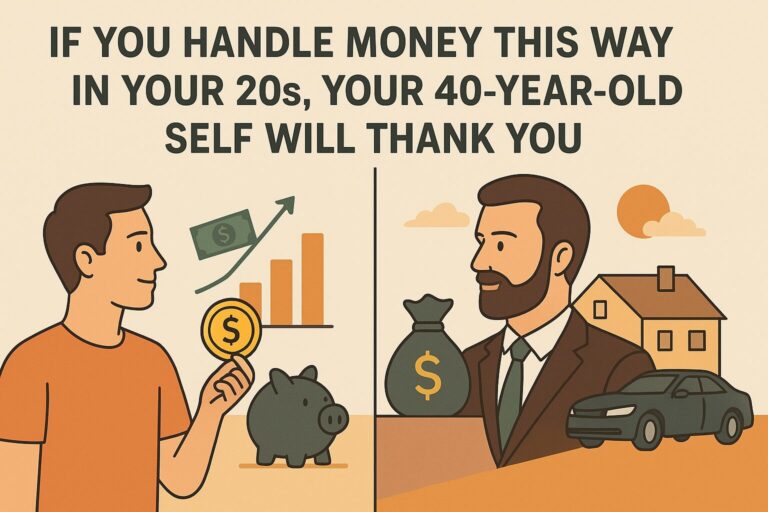When you’re in your 20s, your 40-year-old self is hard to picture. They’re a little like a distant cousin—you know they exist, you’ll meet them eventually, but you can’t quite imagine what their life is like.
Here’s the catch: that future version of you will live entirely inside the consequences of the decisions you’re making right now. Every dollar you save or burn through, every habit you keep or abandon, every short-term temptation you give in to—it all adds up. Some of it will quietly work in your favor. Some of it will quietly work against you.
I’ve seen enough people cross that 20-year bridge to know the gap between the financially relaxed and the financially cornered at 40 almost always starts back here. And it rarely comes down to winning a massive salary early. It’s usually a handful of unglamorous but consistent habits that create enough space for compound interest, career growth, and life flexibility to do their thing.
Here’s how to treat money in your 20s so that future-you is genuinely grateful you didn’t screw it up.
1. Live Below Your Means Without Feeling Like You’re Punishing Yourself
Too many people hear “live below your means” and picture a joyless, penny-pinching existence. In reality, it’s about building a lifestyle you like that just happens to cost less than you earn.
If you’re making $3,500 a month and living well on $2,800, that $700 gap isn’t deprivation—it’s breathing room. It’s the margin that gives you choices later on.
Lifestyle creep is the default setting for most people. As your income grows, your brain resets the “normal” level of comfort and wants more. The only way to avoid it is to decide ahead of time how much lifestyle you’re willing to upgrade and how much stays locked into future security.
Mini case study:
- Alex at 25 earns $42,000, spends $35,000. With every raise, he keeps spending roughly the same and invests the difference.
- By 40, without making any extreme moves, Alex has over $250,000 invested (assuming 6% annual growth), plus a paid-off car and zero credit card debt.
Meanwhile, a peer who lets expenses rise with every raise might be earning more on paper but still sweating every bill.
| Income | Spends Like… | Annual Savings | Net Worth at 40 (6% return) |
| $42k → $80k | $42k → $80k | $0 | ~$0 |
| $42k → $80k | $35k → $50k | $7k–$30k/year | ~$250k+ |
2. Put Good Habits on Autopilot
Willpower is unreliable. Even the most disciplined people have months where saving “slips” because something came up. Automating the right financial moves means you don’t have to negotiate with yourself every 30 days.
Things worth putting on autopilot in your 20s:
- Retirement contributions (even 5% is worth it when you start early)
- Transfers to your emergency fund
- Extra principal payments on debt
Once it’s set up, it’s like a treadmill that runs in the background—quietly moving you forward whether or not you’re feeling motivated.
When U.S. companies started automatically enrolling workers in retirement plans in the early 2000s, participation jumped from 49% to over 85%. People didn’t suddenly become more financially responsible—they just went with the default.
3. Build an Emergency Fund Before You Think You Need It
An emergency fund is one of those things you forget exists until you don’t have one and everything gets harder.
Your 20s are full of unpredictable hits: your car’s transmission dies, you get laid off, and your roommate moves out unexpectedly. Without cash to absorb the blow, you turn to debt. And once you’re in, it can take years to climb out.
Start with three months of living expenses. If your income is unpredictable, aim for six. Keep it in a high-yield savings account or a money market fund—somewhere easy to access but far enough away that you won’t “accidentally” spend it.
The point isn’t to earn a return here. The point is to buy yourself options.
4. Learn the Basics of Investing—Then Start Right Away
Many people in their 20s wait to invest because they feel underqualified. They tell themselves they’ll “start once they know more.” The problem is, the single biggest factor in investment success isn’t knowledge; it’s time.
If you start at 25, even small amounts grow into something substantial. If you wait until 35, you’ll need to save far more to catch up, and you’ll still end up behind.
Keep it simple:
- Low-cost index funds or ETFs
- Retirement accounts like a 401(k) or IRA
- Automatic contributions so you don’t skip months
Case study: Emma invests $200/month from 25. Liam waits until 35 and invests $400/month. By retirement, Emma has more, even though she invested less, because her money had a 10-year head start.
5. Avoid Debt That Buys You Nothing
Debt isn’t inherently bad. The problem is bad debt—high-interest loans for things that don’t grow in value and don’t improve your earning power.
Student loans for a degree with strong career potential can make sense. A modest mortgage on a home within your means can work, too. But credit card balances for clothes, vacations, or gadgets? That’s not just expensive; it’s a habit that compounds in the wrong direction.
If you must borrow for something nonessential, do it with a short, aggressive payoff plan, not “minimum payments until further notice.”
6. Keep Housing Costs Under Control
Housing is where budgets often break. Spend too much here, and it crowds out your ability to save or invest.
The financially stable 40-year-olds I’ve talked to tend to have one thing in common: they never maxed out what the bank said they could “afford.” Many had roommates longer than they wanted or bought smaller homes first, then traded up later without drowning in a massive mortgage.
Aim for housing costs under 30% of your gross income. If you can keep it under 25%, you’ll feel the difference in every other part of your budget.
7. Treat Windfalls Like They Don’t Exist
Unexpected money—bonuses, tax refunds, freelance income—has a way of evaporating. The easiest way to make it work for you is to decide ahead of time where it goes.
One simple split:
- 10–20% for guilt-free fun
- The rest to savings, investments, or debt payoff
Do that consistently for a decade, and you’ll have serious money put aside without ever feeling like you “gave up” your bonus.
8. Let Career Growth and Money Growth Work Together
Your 20s are prime time for career acceleration. The skills, relationships, and opportunities you build now multiply over decades.
Push for projects that stretch you. Keep learning through courses and certifications. Change jobs strategically when it makes sense. Staying put for too long in a role with no growth often costs you far more in the long run than the stability is worth.
Most lifetime income growth happens in the first 10–15 working years. Make those years count.
9. Track Net Worth, Not Just Spending
Budgets are important, but they only show the short-term picture. Net worth shows whether your financial life is actually improving.
Assets minus liabilities—that’s it. The number doesn’t have to be big in your 20s. Watching it grow over time keeps you focused on the big picture and stops you from mistaking high income for true wealth.
10. Decide What “Enough” Looks Like
Without a definition of “enough,” it’s easy to spend decades chasing numbers that never feel like they’re quite enough. People who find peace with money by 40 usually set their threshold early. That way, they can take risks, change careers, or work fewer hours without feeling like they’re failing.
The Compound Effect From 25 to 40
| Habit Adopted at 25 | Monthly Contribution | Growth Rate | Value at 40 |
| Retirement investing | $300 | 6% | ~$87,000 |
| Extra debt repayment | $100 | Avoids $10k+ interest | Debt-free years sooner |
| Emergency fund | $100 | N/A | $18,000 |
| “Found money” savings | $1,000/year | 5% | ~$23,000 |
Nothing extreme here—just living slightly below your means, automating smart moves, and keeping housing and debt in check.
Side-by-Side: How 20s Habits Shape 40s Outcomes
The table below distills the compound effect of the habits we’ve discussed. It compares two fictional people—Jordan (who builds these habits) and Taylor (who doesn’t)—starting at 25 and looking at their situation at 40.
| Habit Area | Jordan at 25 | Jordan at 40 | Taylor at 25 | Taylor at 40 |
| Spending vs. Income | Lives on 75% of income | Savings rate now 30%+; flexible lifestyle | Lives on 100% of income | Little to no savings; high fixed expenses |
| Automation | Auto-saves/invests 15% | Investments grow without constant effort | Saves “when possible” | Inconsistent savings; missed opportunities |
| Emergency Fund | Builds 3–6 months’ expenses | Avoids high-interest debt in crises | No buffer | Relies on credit cards for emergencies |
| Investing | Starts with low-cost index funds | Portfolio exceeds $150k | Delays investing until late 30s | Small portfolio; limited compounding |
| Debt | Pays off student loans early | Debt-free except mortgage | Carries high-interest debt | Still paying old debt; high interest paid |
| Housing Costs | Keeps under 30% of income | Extra cash for investments/travel | Spends 40%+ on housing | Little room for savings |
| Windfalls | Saves 80%+ of bonuses/refunds | Funded major goals without debt | Spends all windfalls | No lasting benefit from extra income |
| Career Growth | Seeks promotions, skill-building | High salary; more options | Stays in comfort zone | Modest salary; fewer options |
Why Your Future Self Will Be Grateful
By 40, life will have thrown you curveballs—career changes, maybe health issues, maybe kids, maybe a move you didn’t expect. If you’ve built these habits in your 20s, you’ll face those moments from a position of choice, not panic.
The real win isn’t the size of your bank account. It’s being able to say yes or no without money deciding for you. That’s the kind of freedom that future-you will quietly thank you for every single day.



